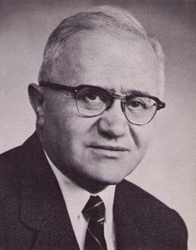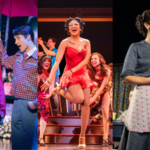
Those who love the theater, both those who work in it and those who still go to it, can be grateful for John Gassner. Whether he wrote for the New York Times or a periodical, his reports and critiques were always well-considered, thoroughly documented, and wisely phrased. Even occasional pieces, written nearly four decades ago, still make interesting reading, though many of the plays and players they celebrate have long since been forgotten. More than that, though, those critical analyses constitute invaluable records of the period.
On April 2, 1967, John Gassner died at New Haven in the sixty-fifth year of his life.
His passing was the sad signal for the customary survey of credits and contributions, for eulogies and words of praise. In his case, the list of achievements and honors is truly notable. It parallels the development of the American theater of his time. The tributes that have been paid him by family, friends, colleagues, and students have been distinguished by the depth of personal feeling revealed. Unlike so many eulogies, they have also been memorable in that every word of praise was thoroughly deserved, justly earned.
Although he periodically urged the necessity for, and the constructive value of, negative criticism, as a critic, teacher, and friend he always tempered his judgments with humor, hope, and encouraging alternatives. This was nowhere better testified to than at his funeral service in New York City.
Among the speakers, playwright Robert Anderson and Yale School of Drama Dean Robert Brustein, their voices revealing the shock of loss, spoke not so much of his achievements, which were too well known to need repeating, but rather of the things he had done for them: how his help, advice, and friendship had influenced their lives and careers. Later, at a memorial service at Yale, held in front of the then unfinished set for the Robert Lowell adaptation of Prometheus Bound, the same thread was picked up by a number of sorrowing friends and students. The sense of loss was not purely that of a great teacher gone, a distinguished critic departed, but also that of a dear, beloved friend vanished from sight. A rabbi, Robert Goldberg, spoke of Professor Gassner’s wide-ranging humanism. His editor, Herbert Michelman, stressed his extensive knowledge and boundless interests. The noted French scholar, Henri Peyre, evoked his wisdom and wit so warmly, so richly that those present were moved to smiles, even to laughter. That, one feels, is what John Gassner would have wanted. Tears and mourning are wasted, for he is still with us in spirit.
Dramatic Soundings is an effort to prevent the erosions of time, to preserve important and insightful essays on theater by one of its most devoted critics and teachers. The present volume is actually the third in a series of Professor Gassner’s collected reviews and comments. The genesis of the project is typical of life with John Gassner, and it is worth telling the story in Mollie Gassner’s own words:
“For years I had been annoyed that John’s magazine and lecture contributions were gathering dust in the basement of the old homestead on Dahill Road in Brooklyn. Since we were always a ‘talking-it-out’ family, I mentioned this to John many times, but his answer to getting the material between the covers of a book only got a vague, ‘We’ll see, darling.’ ”
I was still bothered by the thought of the dust-collectors, facing me on my return home after four months abroad, and, on our last day in Paris, I decided to talk the matter over with Caroline [the Gassner’s daughter]. My opportunity came when Caroline and I took a walk along the Champs-Elysées that very night. We finally came up with the idea of Caroline doing a book about growing up in our particular home, with a father who was a genius, but who never neglected his role as a man at the head of a household; always with a twinkle in his eye and time for friends and students; always aware of their problems. She was to weave John’s articles into her book. It seemed like a good idea.
Two or three days out at sea, Caroline was about to mention this project to John when she and I began to laugh out loud, for the idea suddenly struck us that she could not do this particular kind of book while her father was alive. Poor John! Now he was really in for it; he was not only confronted by a nagging wife, but by a daughter—fresh out of Smith College and whom he adored and respected—who agreed that Mother was right. He agreed to put the essays into a book. Accordingly, Caroline got all the articles together, dated them, sorted them, and piled them on a table. They collected dust again, while she went off to Columbia for her M.A. She and I nagged again and again, and finally the manuscript [The Theatre in Our Times] went off to Crown and was duly published. Theatre at the Crossroads followed later, and now Dramatic Soundings.
A representative selection of essays and reviews was made; structural divisions were established; the copy was edited and set. Unfortunately, at this time Professor Gassner was recovering from an illness that had greatly weakened him, though it did not decrease his appetite for work. His obligations to his students at the Yale School of Drama, his commitments as a regular Broadway reviewer, as well as several pressing publication projects prevented him from making final corrections, additions, and deletions to the galley proofs. It was his intention to do this work on a summer trip to Europe in 1967.
He could not have known that this would be a posthumous book. He was, in so many ways, still a young man in spirit and outlook. More books were planned, to add to the already lengthy shelf of Gassner titles.
In the summer before his passing, I visited him in New Haven to discuss the Broadway and Off-Broadway reviews on which I collaborated with him for the Educational Theatre Journal. Noting my avid interest in opera and operetta at home and in Europe, he urged me to write a book about the problems and practices of musical-production. And then, slowly and thoughtfully, he said, “If I live, I’d like to do a book with you in a year or two.”
Now that can never be. My small part in helping finish the editing of Dramatic Soundings must suffice. Credit for the work goes, of course, to its author and to his loving wife, Mollie. She accompanied him to the theater constantly. He was fond of pointing out how often, in discussing a production with her, she was able to help him make a more balanced evaluation. Since his method of composition was generally to scribble his always well-organized thoughts in a kind of hieroglyphic on various pieces of paper he found at hand, Mrs. Gassner was more his translator than his amanuensis. This was a working-partnership in every sense. Dramatic Soundings is, therefore, not only a memorial to its creator, John Gassner, but also a tribute to Mollie Gassner. He intended to dedicate the book to her as a small token of the years, of productive collaboration and happy marriage.
Students and friends of the Gassners can testify that it is impossible to think of John without Mollie. One of his favorite prescriptions to angry young bachelor playwrights and critics, smarting from rejection and frustration, was to urge prompt marriage with a young woman with the qualities of Mollie Gassner. This is excellent advice, but the prescription is unfortunately not easy to fill.
Much of the arrangement of this book and most of the editing is the work of Nick Lyons, of Crown Publishers, Inc. My contribution has been to study the marginal indications Professor Gassner made on the galley-proofs, as reminders to himself of the alterations he would effect on that summer trip he was never to make. I have deleted where he wished deletion, shifted some material where he wished it shifted, and added the explanations he indicated. In general, instead of trying to outguess him, I have merely cited his notations, offering an additional comment where I believe it represents his point of view. A span of decades separates some of these essays, and, while Professor Gassner’s appreciation of innovation always kept pace with theatre development, it is remarkable how the central tenets of his criticism do not waver. Rather, they are adapted to new subject-matter and new periods with wisdom and wit, instead of the dogmatism and peevishness of some younger critics. This means, however, that repetition of concepts or judgments occasionally may occur.
Professor Gassner was intent on removing as much reiteration as possible. Some essay-proofs were heavily marked with marginal deletion signs. Others were not touched, although favorite anecdotes recur, as they so often do in professorial lectures. If a good story makes a point in 1942, it may still serve in 1962. Besides, the lecturer-writer will probably have a different audience—or, if the same eyes and ears are present, at least he will have few with total recall. As much as possible, repetitions of quotes, illustrations, and judgments have been removed, but there are several instances where the same story or fact make quite good, even essential, points in different essays. Also, in discussing certain periods and specific playwrights, Professor Gassner often qualifies his remarks by noting typical plays or outstanding features of content and style of the period. This creates a potentially irksome sense of the déjà vu the umpteenth time one encounters references to, say, Paul Green’s Hymn to the Rising Sun, in the series of essays on the Thirties; but trial excision of such repetitions damaged the wholeness of individual essays, which were usually not conceived in relation to each other and which were, in some cases, written years apart.
Since Dramatic Soundings is just that, the depth varies, as do the inland waters and the high seas on which Professor Gassner is navigating. The first section, “Soundings in World Theatre,” surveys and judges the work of a number of masters from the distant and the recent past. The second, “Dramatic Theory and Practice,” shifts its focus from playwrights to the crafts of writing plays and evaluating them. The third division, “Perspectives on American Theatre,” is a rough chronology of American drama, seen through essays and reviews, from the beginnings to the present. “The Thirties,” the fourth section, is separated from the previous sequence because its bulk and particularity are not balanced by that of any other period in American theater represented; it is a young book, by itself, and it has special interest in that it mingles Gassnerian appreciations written during the heat and fever of the Depression with the sober reevaluations of later years. For readers who were too young to know the years of the Federal Theatre, Professor Gassner’s contemporary evocation of this time of ferment and experiment may prove more immediately informative than recent works written very much after the fact. The fifth section, “Broadway in Review,” covers productions of the Sixties, and represents typical reviews written for the Educational Theatre Journal, for which the author was drama-critic from 1951-1967, generously donating his services to this professional quarterly. It is divided into two parts, the first being those selected by Professor Gassner himself, prior to 1965, and the second being those I have chosen from later reviews. The latter are arranged according to subject- matter, and, where possible, chronology, to provide a more effective display of the author’s critical practice. The sixth section, “The Modern Vision in Drama,” treats new movements and modes in thinking about and writing for the theater. If some of the essays, especially those dealing with poetry in the theater—a subject aficionados periodically urge on a generally disinterested public—seem slightly dated, it may well be that the search for novelty has become as feverish on stage as it has on canvas. This year’s fad is next year’s ancient theatrical history.
A curious discovery may be made by the careful reader. Professor Gassner, in person, was the epitome of courtesy, interest, and kindness. These qualities are also present in his writing. He has, in fact, been criticized by younger critics for being too kind, too forgiving, too soft. The general impression of gentleness, of thoughtfulness, is not an incorrect one, but it does not tell the whole story. Reading the reviews in Section Five ought to dispel the notions that he was a purely avuncular figure or a critical Santa Claus, despite his enthusiastic championing of experimental plays and new playwrights. When he was displeased, he could voice his displeasure in very definite, stinging terms. When he was dissatisfied, he was able to make that quite apparent, demonstrating the whys and hows. He shows, for example, a real admiration for the talent of Edward Albee, but he also takes him vigorously to task for his carelessness in construction, his casualness in thought. Professor Gassner, it can be seen from his reviews, was in the lead in appreciating new ideas and methods. He did not mourn the loss of a theatrical tradition: he begged for the establishment of a new one.
If he needed any defense from charges of conservatism–which he does not–one would only have to cite the Pulitzer Prize affair. In 1963, he and John Mason Brown, acting as the Pulitzer Drama Jury, recommended Who’s Afraid of Virginia Woolf? for the annual drama award. Their 1960 choice, Lillian Hellman’s Toys in the Attic, had already been passed over, so it was no great surprise when the Pulitzer Advisory Board did not honor the selection. As a result, the Columbia University trustees made no award in drama, not wishing to risk the moral dangers attendant on loading with laurels a work that contained real “four-letter” words. Not only did the Jury resign; they also made their disgust known. Professor Gassner’s “Too Many Judges?”—reprinted in Section Three, from the New York Times—vigorously discusses the issues.
Several months after this introduction had been composed, and shortly before final changes and additions were sent to the printer, Professor Gassner’s Preface was discovered among notes for work in progress. It excellently sums up his character and career. If anything, he has been too modest. His distinctions between reviewing and criticism are significant, worth remembering. Regardless of the general truth of his remark that “almost every review, often mostly a summary, of a play or book passes for criticism,” the careful reader can see that Gassner critiques are seldom plot-summaries. Indeed, when a synopsis of dramatic action is offered, it is usually necessary for a subsequent analysis of the virtues and/or defects of the structure, an analysis for which Professor Gassner’s work as a play-editor for the Theatre Guild and later for Columbia Pictures especially qualified him. At Mrs. Gassner’s wish, the Preface has been printed exactly as written, without corrections or additions.
To me, Professor Gassner’s friendship, interest, and aid was especially welcome, if unexpected. I was never a student of his, and my first contact with him was the result of a testy letter I had written, suggesting that Yale School of Drama graduates seemed to have a corner on all the grants, awards, and recommendations to be had. I was amazed to find how embracing his concern could be and how many people, also not Yale alumni, had profited from his interest and intervention. He was, I was astonished to discover, genuinely anxious to know what I thought of his criticism, his choice of plays in A Treasury of the Theatre, and the prospects of various young American playwrights. Now, in reading over and over the proofs for Dramatic Soundings, I understand at last that I was his student.
Everyone who has read any of his books, Masters of the Drama, Producing the Play, Form and Idea in Modern Theatre, or Theatre at the Crossroads, has been his student. And it is through them that John Gassner continues to be among us. He will live as long as his books are read, as long as his students create, write, and teach with the curious mixture of humility and audacity, scholarship and humor, incisiveness and generosity that marked his life and work.
-GLENN LONEY
New York November, 1967



